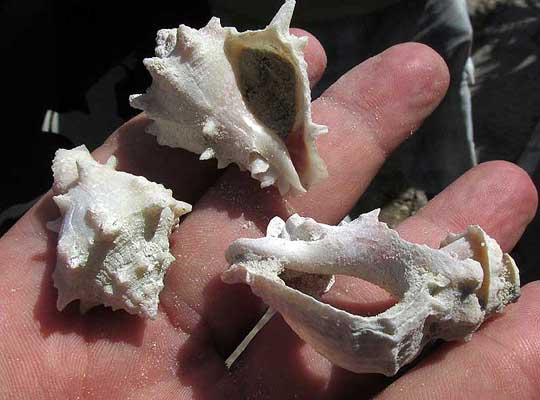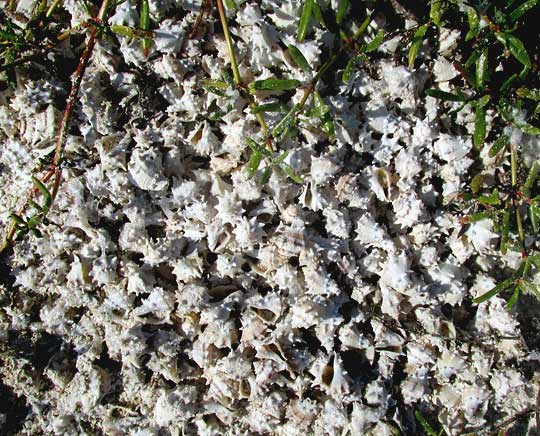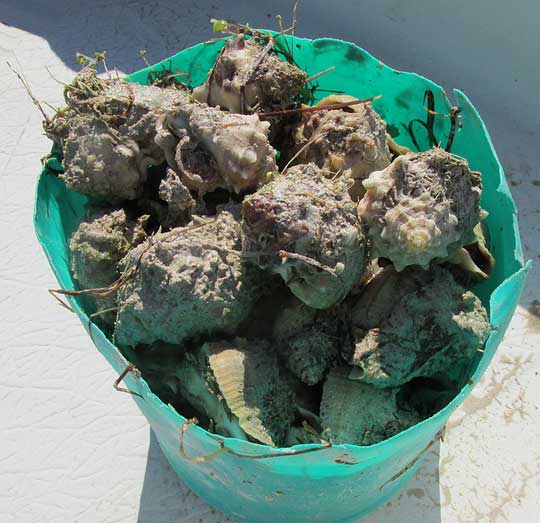Excerpts from Jim Conrad's
Naturalist Newsletter

from the May 31, 2015 Newsletter issued from Río Lagartos, on the Yucatan Peninsula's northern coast (~N21.60°, ~W88.16°), Yucatán state, MÉXICO
CROWN CONCH/ CHIVITA
At least at the eastern end of Ría Lagartos Estuary where the water is shallowest, saltiest, and broad mudflats emerge at low tide, one seashell-producing, gastropod-type mollusk is by far the most commonly encountered of all fair-sized species. If you walk barefooted in shallow water, with almost every step you feel them buried in soft mud beneath your feet, and along shore, bleached, empty shells abound. During the winter I seldom saw living individuals, only their shells. But now at low tide you find thousands scattered across freshly emerged mudflats, such as the two-inch (5cm) one shown above.
That picture shows that the mollusk's flesh is white but that its operculum is brown -- the operculum being the "lid" or covering that seals the shell's opening when the body is withdrawn into the shell. Most commonly you find empty shells, however, often broken ones, as shown below:
 .
.
A distinctive feature of the shells is their blunt "teeth" arranged in spirals that are best displayed when a shell is viewed from behind, as seen below:

Volunteer identifier Bea in Ontario pegged this abundant species as MELONGENA BISPINOSA, usually called the Crown Conch. Around here they're known as Chivitas, maybe because a chiva is a goat, and goats have horns like the shells. Earlier the species was considered a subspecies of the widely distributed, common and highly variable Melongena corona. Just by looking at the shells I can't see any difference between the two species, but Mexican researchers refer to Melongena bispinosa, Chivitas, as the common species found here, so I'm using that name. Melongena bispinosa is endemic to estuaries along the Yucatan Peninsula's coast.
Sometimes you find masses of Chivita shells along shore, as shown below:

That's where people have thrown shells after removing their fleshy contents, to be eaten. I'm told that at low tide sometimes people go collecting large numbers of them, set up their kettles there in the tidal flats, drop their Chevitas into boiling water, gouge out the fleshy contents, leave the empty shells in piles, and take home the edible part. More commonly, a family or one or two guys show up walking along the estuary's shores picking up Chivitas and dropping them into bags, as shown below:

In a 2003 issue of Mexico's Ciencia, poetically entitled "La nobleza, belleza y via crucis del recurso pesquero caracol 'chivita' en Yucatán," Vicoria Patiño Suárez and others report that just in the small coastal town of Chuburná Puerto, NNW of Mérida, with a population of 1720 in 2005, 70% of the people collected Chivita during part of the year, removing an incredible 256 tons of them. That translates to an annual loss of about 77 million Crown Conch individuals, which, the authors suggest "... can't be considered as subsistence fishing, and which requires control in order to be sustainable."
The study also points out that other mollusk species also are vigorously collected as food, including Queen Conch (Strombus gigas), the Milk Conch (Strombus costatus), Horse Conch (Pleuroplaca gigantea), West Indian Chank (Xancus angulata) and various species of whelk (Busycon sp.) That study in Spanish can be freely downloaded in PDF format here.
An interesting inclusion in that study is a chart showing that compared with pig flesh consisting of 16% protein, beef flesh of 18% and chicken flesh of 20%, Chivita's flesh consists of 39% protein.
On a recent flamingo viewing trip our boatman saw so many Chivitas wandering the mudflat onto which our boat was pulled that he couldn't resist gathering some for himself. He took them home and made the locally popular dish "civiche." He filled the container normally used for bailing water from the boat with muddy Chivitas, as shown below:
